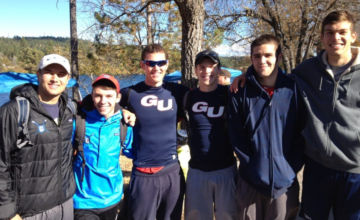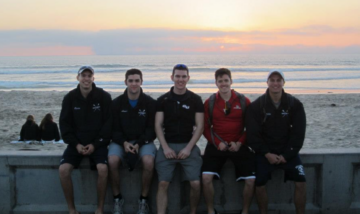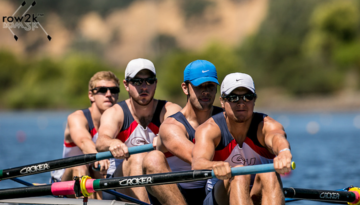by Eric Schenck

Rowing is a sport that you naturally underestimate. You think of canoes, of guys with perfect hair, of leisurely strolls on a lake while the glorious sun shines down.
From my experience, that’s not even close to the truth.
In reality, it’s brutal. If you’re doing it right (going fast) rowing is torture for the body. Not canoes, but long shells that only move if you do. Not perfect hair, but blacked out vision and legs on fire. Not a glorious sun, but on the water by 6 AM and a January river that doesn’t care how freezing you are.
Rowing will chew you up and spit you out.
And it’s worth every second.
…
I’m on Gonzaga University’s crew team my first two years of college, from 2011 to 2013.
I have my mom to thank. Before my freshman year at Gonzaga University starts, we are walking on the campus for the first time. One of the university’s rowing coaches is doing in-person recruitment. She points over and tells me I should try it out.
I shrug my shoulders and walk over to talk to him. This is how it starts.
…
You need to walk before you run. Rowing starts not in boats, but ergs.
Ergs (short for ergometers) are where we begin with the correct rowing form. Things start easy. These ergs seem like a piece of cake. Not only do they look funny to me, but they’re not nearly as difficult as I imagined.
Little do I know that this is just the beginning. Ergs will quickly become the most ruthless form of exercise I’ve ever done. But I don’t know that now. And thank God for that.
A few weeks later we finally get in the water. Everything is awkward. Picking up the boats and walking them down to the river, learning how oars work, making sure we don’t slam a 50,000 dollar shell into a dock…
Nothing I’ve ever done prepares me for any of it.
But it’s great. We bumble our way through the things we absolutely need to know and go from there. And as terrible as most of us are, there’s a special kind of rush when you first get into the boat. That never really goes away.
I also slowly, gradually, learn how an eight-person boat works. The number one and two seats in the back are mostly responsible for balancing the boat. The seven and eight seats in the very front set the rhythm. Three through six are the “powerhouse”. These are the rowers most responsible for moving the boat. Most of the two years, I sit at either three or five.
I’m introduced to port vs. starboard rowing. As a port rower in a typical eight-person boat, the oar is on your right side. As a starboard, it’s on your left. By chance, I start as a starboard. I will stay one the entire time I’m rowing.
A special bond begins to form with the other rowers. We’re all waking up at 5:30 AM to make it to practice and sleepwalking through our morning classes afterwards. The coaches started easy on us. Now that we’re a few weeks in, things start to get hard. From now on, they’ll stay that way.
As people drop out and stop coming to practice, the numbers thin. We start to hang out outside of practice. Friendships form. It’s easier to bond with people when they’re just as tired as you are.
…
Never have I felt so connected to nature. There are two places we usually row: a river that never freezes over, and a lake that does. Where we head to in the morning really just depends on how cold it is.
The lake is the worst. The water (when it’s not ice) is constantly choppy. There are hardly any trees. The wind makes it feel like we’re rowing in some Soviet wasteland. The lake is also huge. Our coaches send us 10 miles down to the end, and we turn around and come right back. There’s hardly anything to see.
But the river? That’s where I fall in love with everything I see. We’re surrounded by green hills the entire way. The water is usually flat, and deer run along the side to keep up with our boats. The river is where the intense workouts happen. With everything we have to look at, though, they’re not nearly as bad.
…
Training for rowing involves more than just being in boats. We go for runs. We lift weights. If we’re lucky, our coaches will even let us hop in an ice bath and call it a day.
But the erg is the most grueling, by far. And even worse? All erg trackers are hooked up to the giant screen in the front so you can see in real time where everybody ranks.
Back-breaking work mixed with a little shame.
Here are the three most common erg workouts we are timed on:
2K: “The Dreamcrusher”
This is the length of the races you see in the Olympics. Everything you do in rowing practice, both on and off the water, is in service of the mighty 2K.
The first time we do one I don’t buy into the hype. Depending on how fast you pull, it only takes about six-and-a-half minutes. What could be that bad about it?
Everything, apparently.
I think I’m prepared for my first 2K sprint. But I’m not. Maybe you can’t prepare for it. Most of us are newbies, and we don’t know how to pace ourselves. Halfway through, with another three minutes to go, I start to sputter. I’m a car that’s run out of fuel 50 miles from a gas station. Any kind of energy I have to get through it is gone with 90 seconds left, and I spend the last minute hating the fact that I was ever born.
My chest is on fire. The cramps in my feet are unreal. I limp across the finish line of my very first 2K, every part of my body screaming in pain. I vow never to do another one, but it’s only the first of many.
To call a 2K a “Dreamcrusher” is all too accurate: it literally starts to terrorize my dreams. The night before we get tested on it I usually sleep like shit. My body knows what’s coming.
5K: “The Burner”
This is 2.5 times longer than a 2K, but you’re still expected to go fast. That’s why I call it The Burner. You don’t have the luxury of letting off a bit like you have with the 10K, and it will hurt just as bad (but in a different way) as the 2K
A 5K test my sophomore year is one of the worst days I have on an erg. We begin ten minutes after I start to get a migraine. It’s a rarity for me, and it’s come at the worst possible time. I think I can handle it. And for the first ten minutes, I do. But by the time I hit 2,000 meters left, my vision starts to go.
I don’t recall the last five minutes of it. All I remember is a bright light flashing in front of my eyes and my head getting hit with a hammer after every stroke. Somehow, I finish third out of 27. Call it angry gorilla energy. I lay on the floor for half an hour, and I’m still there as people start to file out and go home.
I never have another migraine during a 5K. But with how painful this test is anyway, I can’t say it makes much of a difference.
10K: “The Neverending Suck”
This will be somewhere around 40 minutes of constant, mind-numbing rowing. A 10K is more mental than physical. Most anybody in decent shape can keep their goal pace for the first 10 minutes. But 30 more? That’s just cruel.
Halfway through you’re convinced it’s never going to end. You still have a whole other 5,000 meters to row, and at this point, you stop caring where you rank against everybody else.
With 3,000 meters left you still have over ten minutes of rowing. This is when the thoughts start. Your brain is doing everything it can to get you to stop. It’s asking you why you ever even started this, and reminding you of all the nicer things you could currently be doing. Taking a swim. Eating an icecream. Banging your head against the wall – surely all better than a 10K.
You finish eventually, but with how long it takes, it never feels real. How can you finish that which has no ending? You leave that room in a haze, and promptly forget it ever happened. Each 10K is like the first one you’ve ever done.
The 2K, the 5K, the 10K. These three are the “bread and butter” of erg tests, and I’ve done all three more times than I care to remember.
To this day I still don’t know which one of them is the worst. I guess it comes down to how, exactly, you want the erg to kill you. You either take fast but extremely painful, or a slow fire that’s going to get you anyway.
Some kind of death is inevitable. It’s just your choice how it happens.
…
Our two rowing coaches couldn’t be more different. Mark Voorhees sticks with the freshmen. Dan Gehn takes everybody else. If Voorhees is the good cop that makes an effort to hear our story, Gehn is the asshole that’s always on the verge of punching us.
Voorhees is 6’8” and is always laughing about something. He comes to practice in flip flops. He wears a “Don’t Tread On Me” hat, and drives a shitty pickup truck around.
Gehn? Quite different. He always looks like he just caught somebody not using a coaster on his favorite coffee table. Nothing we ever do is quite good enough. His default setting is sour. Gehn probably wasn’t born – he crawled out of the ground as a fully formed, muscle-bound speed demon ready to row the shit out of a boat.
Voorhees feels like he’s one of us, even if he’s not. We respect both of them. Voorhees we like – Gehn we fear.
But as irritating as Gehn can be, there’s one thing he’s exceptionally good at: making us faster.
…
Rowing isn’t like other college sports where you have games every week. Instead, we average a regatta about once every two months. Most of the time these are in the Pacific Northwest.

We go to Seattle several times, and make a trip to Oregon twice. By far, though, the best trips are to San Diego. Southern California is warmer than Washington. The sun shines down on us, and it helps being able to jump into the water after workouts.
After every race we have there, we get tacos.
We’ve never been so deserving of calories.
…
A few months into it I start to hit my groove. I’m having fun.
I’m also changing. It starts with the hands. Within a few weeks, I have scabs and cuts on my palms. It hurts to take showers. Or pick up pretty much anything.
It continues on to my legs. Between 2011 and 2013, my thighs are the biggest they will ever be. It gets to the point where I start to stretch my jeans.
I’m also constantly hungry. I can take in 4,000 calories a day and still be thinking about food. Six days a week I’m drenched in my own sweat. Eating, almost without fail, is what I look forward to.
But it’s not just my body.
I also become, dare I say, a bit more hardy. By November we are rowing on a lake with 40 degree water. We still suck at rowing, and half of us are digging the oar blade too deep. Every splash of water is a bucket of ice thrown on top of me.
But I don’t care.
And sleep?
Who needs it?
…
When you go through so much training, things start to blend together. Two years worth of erg workouts all become the same. But there’s the one that sticks out, and one I will always remember:
Five by five minutes, with three minutes of rest between each piece.
Sounds doable. But here’s the fun part-
The only way you can prevent yourself from more time is going as hard as you can. Everybody’s times is synched on the big screen, and if you don’t finish in the top five of each piece, you have to add another thirty seconds of sprinting.
I don’t know what sick son of a bitch created this hall of agony. Even Coach Gehn isn’t this sadistic.
The first five minute piece I finish third. The second piece I finish fourth, and my vision starts to blur on the sides. The third piece I finish fifth, and even though I haven’t added on any sprints, the floodgates open.
I promptly throw up in a trashcan. I look up before the next one starts, and Voorhees is staring at me. He nods, and I nod back. The fourth piece I’m back in fourth place, and throw up again.
While I’m waiting for the final piece to start, Vorhees comes over and punches me in the shoulder.
“We doing five in a row, Schenck?”
My body is past the point of even nodding. It’s five minutes of actual hell, but I finish back in fourth. I’m one of two guys that’s finished in the top five for each one.
My reward? The trash can. My stomach has long ago been emptied, but that doesn’t stop me. Vorhees laughs. Apparently I’m a winner, but the only tears in my eyes are from the stomach acid.
I spend the rest of the day as a zombie.
Do not bring your hopes or dreams to an erg – it will destroy them all.
…
Still, as objectively terrible as some of these workouts are, you develop a special kind of love for them. Because you know what it’s all for: preparation for moving that boat as fast as you can.
And when you learn how to do that, there’s nothing like it.
The most fulfilling moments with rowing come when we hit “swing”. This means everything is in flawless synchronization, eight bodies of movement perfectly balanced. It’s rare – especially for us.
But when it happens – that’s when all the blisters on your hands are suddenly worth it.
Our coaches usually ride in a motorboat alongside our shells. They see everything we do. Gehn is almost always screaming something at us. Instructions. Pointers. Threats.
But when we hit swing? At that point, there’s nothing left to say. He can see that we’re doing it correctly.
But us? We feel it.
And everytime it happens, there’s a sudden quiet that falls on you. All you hear is your own breathing and every single oar dipping into the water at the same time.
Sometimes it lasts for 30 seconds. If we’re lucky, we have longer.
You probably only slept five hours last night, but if you hit swing, you’ve never felt so alive.
…
I row for two years. My last race is in May of 2013. After that I quit. I stay friends with most of the rowers, and end up living in the same house as five of them.
Only two years, and so punishing, but rewarding in a way that I can’t quite describe. Because I’ve realized this: you don’t just underestimate how difficult rowing is – you also underestimate how it changes you.
How the bleeding hands can teach you perseverance. How the early mornings can teach you commitment. How the shared pain can teach you accountability.
Rowing on the crew team was murder on my body, yes. But it’s also some of the closest connection with other humans I will ever feel. I know I’m never going to experience something quite like it again.
It’s strange to me how something so influential on the personal level can just stop. I’ve never rowed again. I’m hardly in contact with any of the guys I did it with. Rowing was almost my entire life for two years-
And then it wasn’t.
But I do think about it every now and then…
And everything that boat gave us.
Was it free? Definitely not – every time I vomited, every cramp in my legs, and every blister on my hands showed me that.
But some things you can only pay for with grit.
…
The last time I hit swing is the day before my final race.
It’s me, Connor, Devon, and Dan in a four, with Taylor coxing us. We know we’re going to lose badly the next day. Everybody is bigger and stronger than us. But we don’t care. We’re going out with a bang, and we’re going to have the time of our lives doing it.

Maybe the boat senses this. Maybe it knows where our heads are at. Maybe rowing is more a mysterious energy all around you, and it helps you out when it can.
Because five minutes before we’re supposed to start heading in…
It happens. We start rowing in time with one another, and everything clicks.
The sun is setting. All you can see is the person in front of you. All you can feel is four people rowing as one.
We’re moving it just like we should.
Usually there is noise. Almost everywhere. Our coaches shouting at us. Our coxswain giving us instructions. Our blades not quite where they should be.
But not this time.
Once again, that sudden quiet is upon us.
I’ve given everything I can to this boat…
And now it’s sending me off with a smile.
***
Enjoying the content on 3QD? Help keep us going by donating now.
